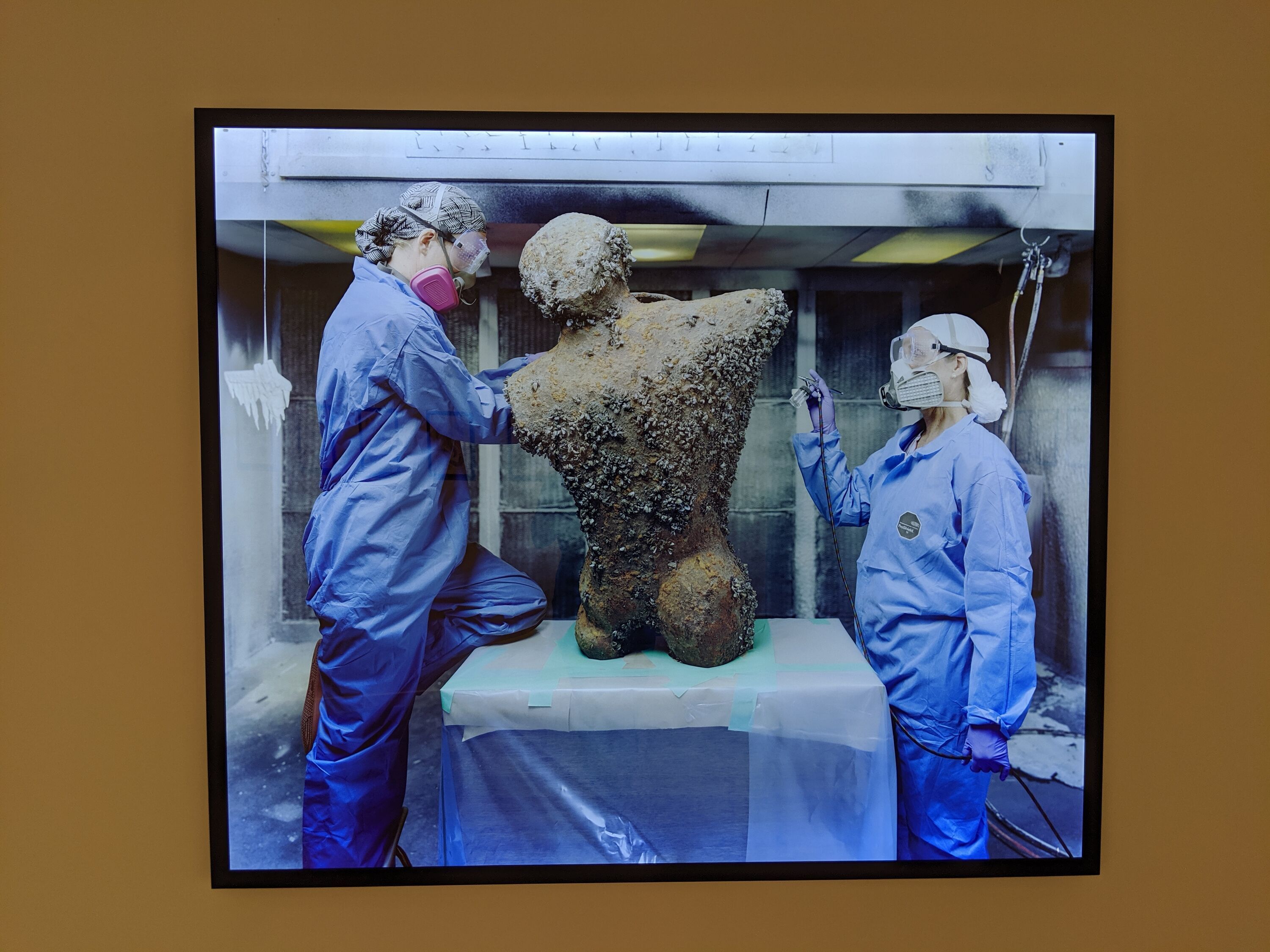
Installing the Crisis: Biennials of Contemporary Art and the New Sociality
What makes the ecological crisis of today a ‘crisis’? Is it the human activities that impact nature or the sociality wherein the crisis is articulated? This visual essay analyzes this form of sociality by looking at articulations of the crisis in contemporary art, with the 16th Istanbul Biennial (2019) as a case study. The biennial exhibited a 'continent' made of trash floating in the Pacific Ocean. While this continent emerged as a result of human-oriented production and consumption processes, it exists outside of human sociality because it is no longer controllable by humans.
This essay has two aims. First, it offers a theoretical exploration of ‘installing the crisis’ by analyzing how the relationship between humans and nature is articulated in the biennial. ‘Installing the crisis’ also refers to modern sociality’s territorialization of the crisis narrative, which includes identifying what causes a crisis as well as the spatiality and temporality of the crisis. Second, the essay explores the new form of sociality that arises from the complex relationality between human and non-human beings, by looking at non-human beings’ impact on sociality, and questions the anthropocentricity of this sociality.
Keywords: anthropocene, crisis, nomadology, relational aesthetics, sociality
Today, we find ourselves exposed to numerous crises. They are the global climate crisis, the Syrian refugee crisis, and the coronavirus crisis, to name but a few. Although it is up for discussion what makes each of these crises a crisis, the concept of crisis emerges as a narrative articulated within our sociality. At the same time, crises influence this sociality. In the most recent example, the coronavirus crisis caused people to redesign their relationship with spaces. Our mobility is mostly limited to the spaces of our homes and supermarkets. What a new, post-crisis sociality will look like is a mystery for now. Some label this new, coronavirus-era sociality the ‘new normal.’ The new normality is envisioned as a site where socio-economic structures are reconstructed and the relationship of people with places is reorganized (Florida 2020). The new normal brings with it new paradigms governing our spatial relationship with places. The concept of adapting to the new normal in order to minimize the effects of the coronavirus, which is outside of our sociality, presumes that this new sociality will also be people-oriented. More precisely, in this sociality, people again think of themselves as the only creatures who have the power to change society and counteract the impact of non-humans.
However, does our new sociality have to be people-oriented? If not, how would a crisis be articulated in a non-human-oriented sociality? Although imagining the existence of such a sociality from the social spaces that we currently occupy is challenging, relational aesthetics (Bourriaud 2002) as a concept of contemporary art promises an avant-gardist understanding that attempts to break the patterns of rational paradigms embedded in today’s anthropocentric sociality. Bourriaud (2002) uses the ‘falling atoms’ example from a poem by Lucretius to explain how art has the potential to challenge socialities’ paradigms. The atoms fall parallel to the ground. However, when an atom leaves its orbit, ‘it causes an encounter with the next atom and from encounter to encounter a pile-up, and the birth of the world’ (p. 7). That is, in relational art, meanings are not embedded in art objects to be exposed to the viewer in a single way, but emerge through the relation of the audiences to the artworks. Therefore, relational art can potentially reveal the existence of alternative socialites, something relevant for articulating a new sociality.
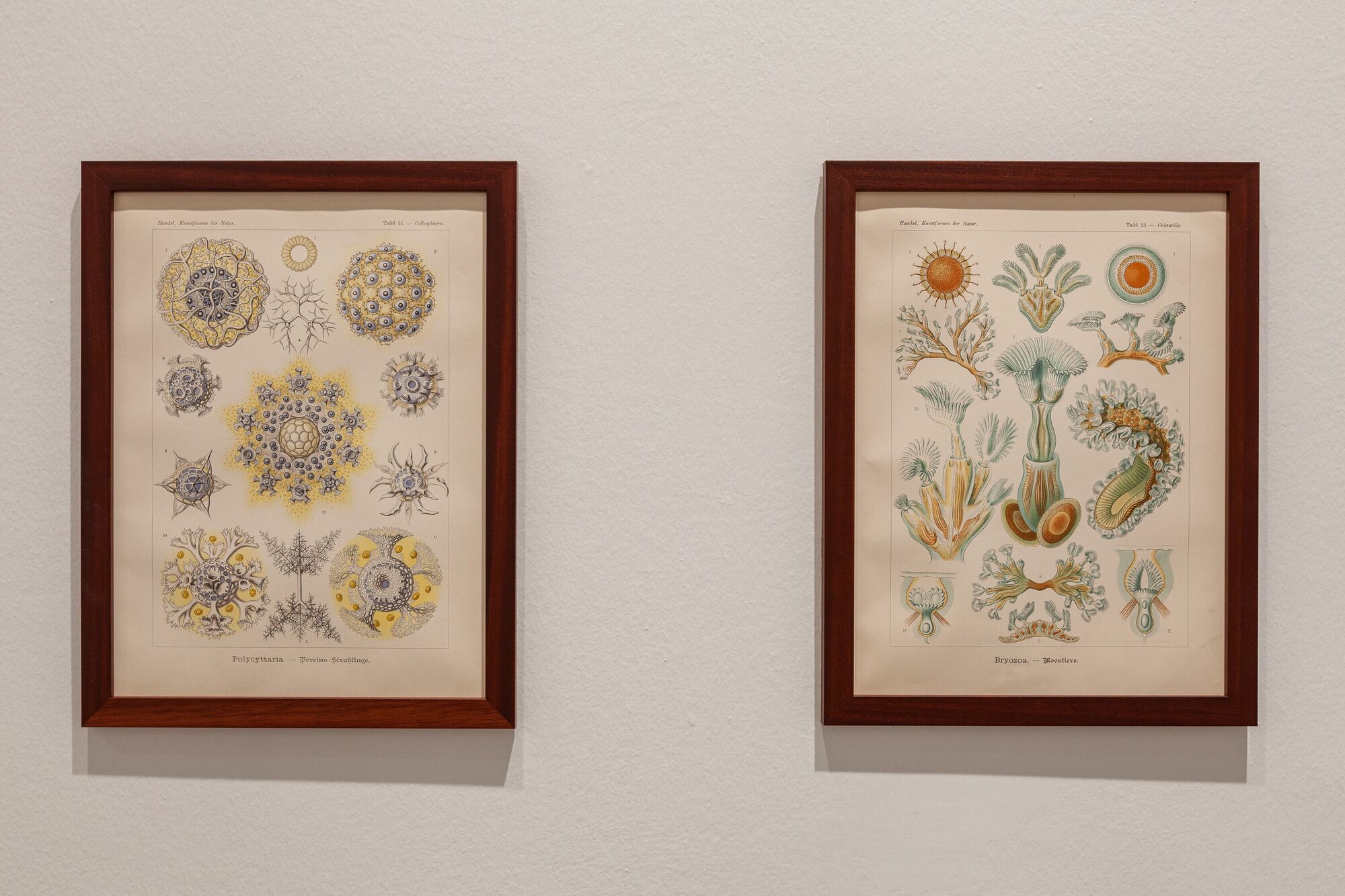
This essay briefly explores this new form of sociality through the emergence of the crisis narrative in contemporary art, using the 16th Istanbul Biennial (2019), curated by Nicolas Bourriaud, as a case study. Although the biennial is titled ‘The Seventh Continent’ after a giant mass of trash floating in the Pacific Ocean (a reference, at first glance, to the ‘ecological crisis’), it frames the ‘continent’ issue as a result of oppositions between culture and nature. In this relationship, culture is identified with rationality and colonizing, while nature represents anything unidentified, that is, irrational. Because the ‘crisis’ phenomenon is highlighted in the biennial as it emerges through the relationship of the rational to the irrational, the biennial does not limit the narration of the crisis to the figure of environmental waste within the scope of ‘ecology’ and invites us to think of what makes a crisis a crisis more broadly.
This essay has two aims discussed in two separate sections. The first is to present a theoretical commentary on the centrality of the crisis. In the relation of culture to nature, nature is not only a place of non-human beings, but the place of all beings, including humans, that are unidentified by a sociality. Thus, the relationship between culture and nature does not refer to an opposition between humans and nonhumans, but to the process by which a societal subject identifies a non-societal one. To explore how this process is articulated, as well as to analyze what constitutes a crisis, I use Gilles Deleuze and Félix Guattari’s (2005) concept of nomadology. The second aim is to explore the new sociality by looking at the role of the non-human object in impacting this sociality, and ultimately to question the anthropocentricity of this sociality. For the analysis, I utilize Bruno Latour’s (1996) actor-network theory. Rather than analyzing the individual artworks in this essay, I engage with the installation of the ‘seventh continent,’ that is, the emergence of the trash island in the Pacific Ocean which gave its name to the title of the biennial, to find out how the relationship between humans and nature is articulated. The visuals of the artworks help me examine the temporality and spatiality of the crisis, and the sociality in which it emerges, allowing me to identify the crisis figure.
The Installation of the Crisis
I want to start with the title of the biennial. The Seventh Continent refers to an artificial continent, also known as the Great Pacific Garbage Patch, that has emerged in the Pacific Ocean. It is approximately six times the size of France. In the Cambridge Dictionary, the word ‘continent’ is defined as ‘one of the seven large landmasses on the earth's surface, surrounded, or mainly surrounded, by sea and usually consisting of various countries.’ According to this definition, a continent is a place where human sociality may exist. So what makes this garbage patch a continent, if nothing but waste exists on it?
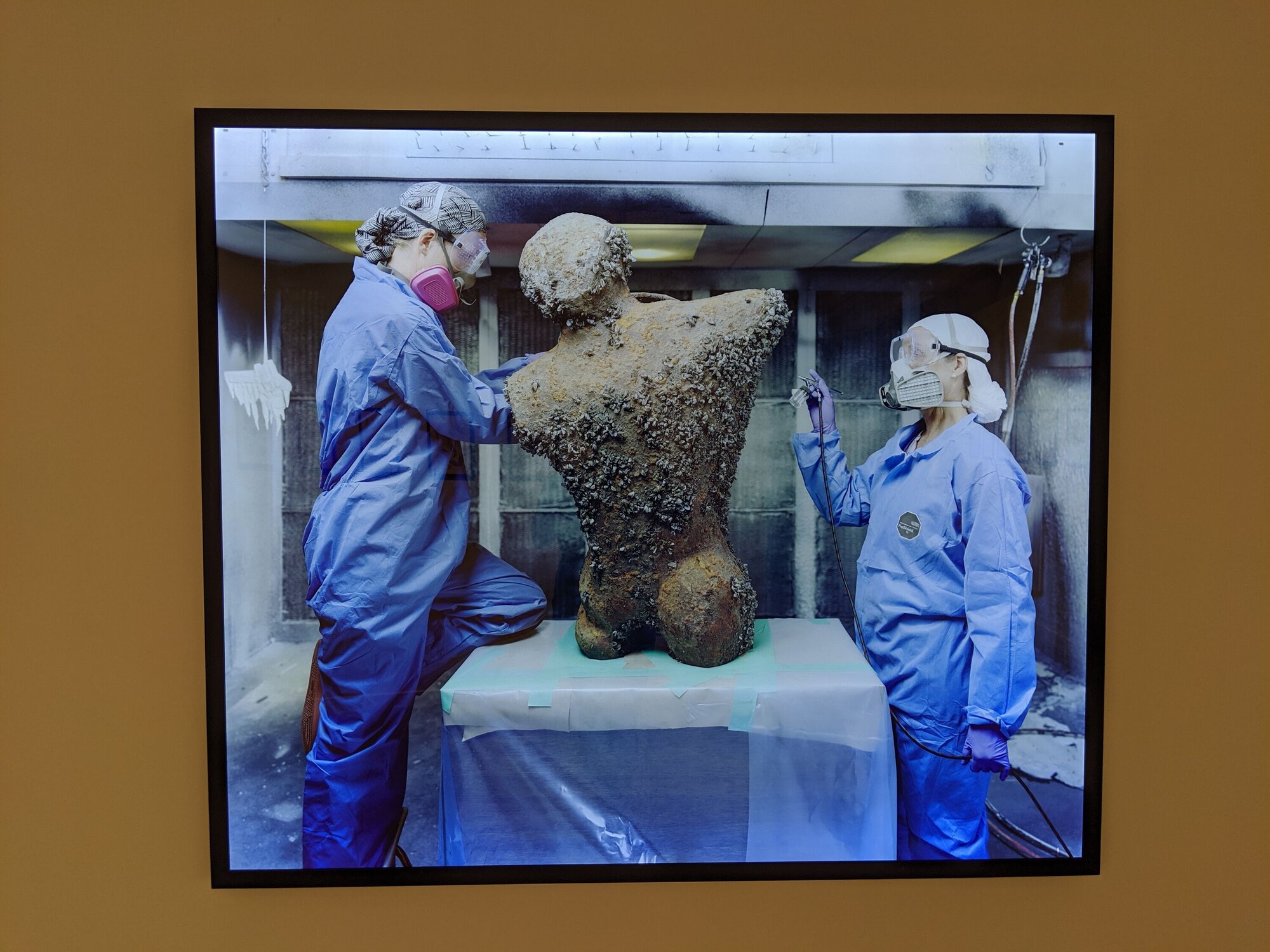
The conceptual framework of the biennial indicates that the seventh continent has emerged as a result of the Anthropocene era, emphasizing humans’ effect on nature. To geologists, while, until the end of the Holocene, human populations were dominated by nature, with the Anthropocene, they started to dominate nature. Although ecological issues such as the continent occur as a result of the Anthropocene, which is documented by scientific research, since these issues arise from cultural, social and political processes, ‘the Anthropocene is social and discursive as well as a scientific phenomenon’ (Stark and Saldanha 2016). The artworks exhibited at the biennial demonstrated that humans’ dominance was not limited to the relationship between human and non-human beings, but also included relationships between humans and other humans outside of their sociality. Therefore, we can also examine colonizing and identifying other beings in the Anthropocene.

In order to deal with the crisis, a sociality attempts to identify what causes it. Identifying the crisis includes defining its temporality and spatiality. Aside from its massive size, the fluid relationship of the ‘continent’ with the land makes its spatiality a threat to anthropocentric socialities, which have a colonial relationship to the land. Deleuze and Guattari’s (2005: 351) concept of nomadology explains the modes of the existence of subjects according to their relationship to the land, which is divided into ‘smooth’ and ‘striated’ spaces. Striated space refers to the land of the sedentary subject, that is, the state. In striated space, there are codifications and sets of rules that are established by the state, that is, the anthropocentric sociality. In smooth space, there are no such hierarchical structures set up by the state. It is outside of the state’s territory; it is the land of nomads. Today, not only the earth but oceans have become striated, even if they are located outside the land borders of countries. The establishment of radar networks, underwater GPS scanning, and routes for transportation indicate the striation of the oceans. A continent outside the maritime borders of countries, in the inner part of the ocean, is a formation that threatens the world. The territorialization of the oceans is threatened by this mobile seventh continent. It is oceanic currents, nature itself, that turned debris into a continent. What makes this continent an actor of the crisis is the meaning it gains in the current sociality. The continent’s nomadic mobility, its ‘war machine’[1] status, its potential to smooth pre-territorialized spaces, lead the striated-space sociality to recognize it as a threat.
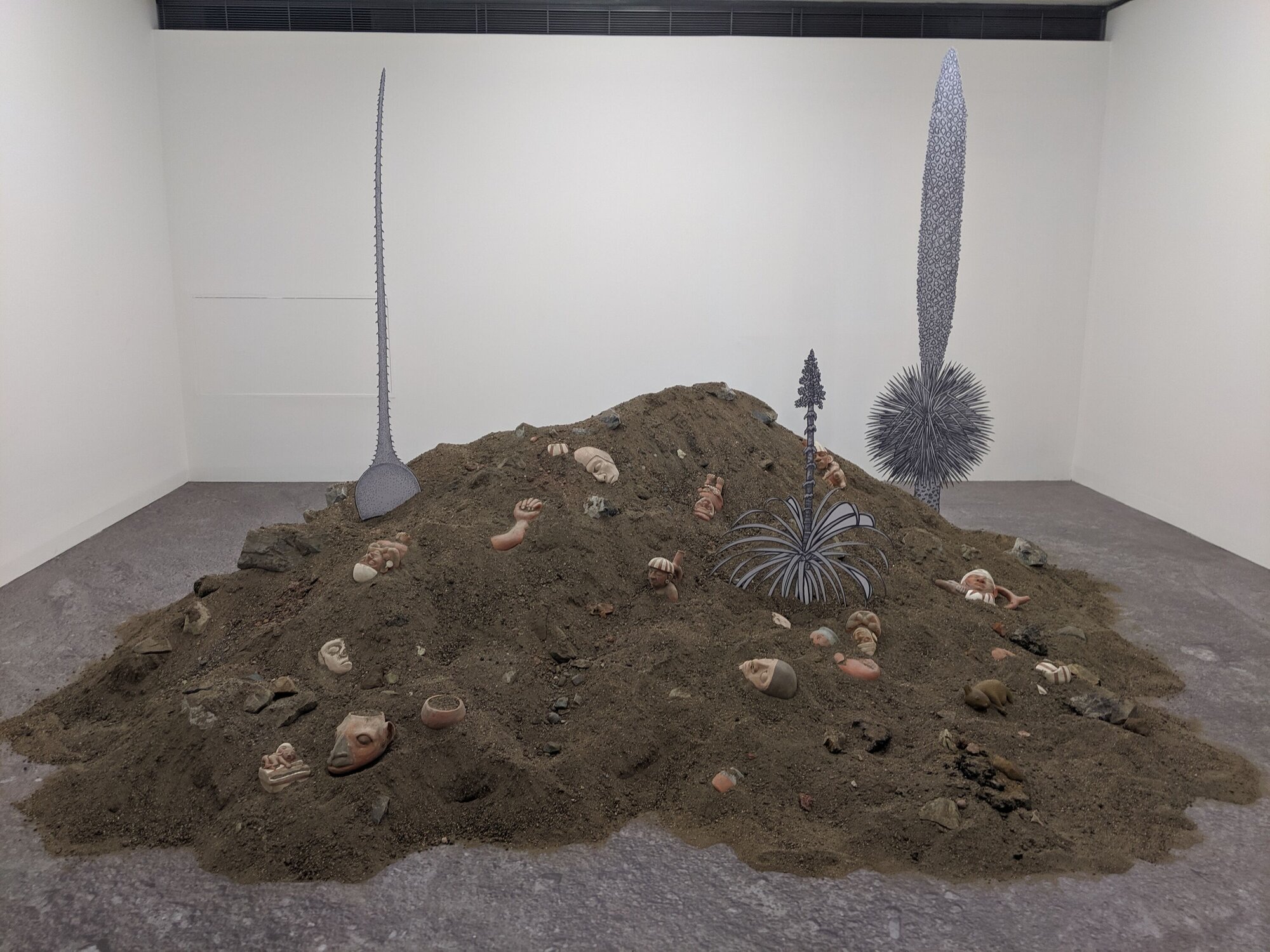
The fluid relationship of the continent to space makes the continent a nomad. Nomads, to Deleuze and Guattari (2005), are beings who are not located in striated spaces and refuse to be codified by the state (p. 386). So, refugees, protesters, the seventh continent, and the coronavirus could be seen as nomads. For instance, the coronavirus is a nomad that moves uncontrollably and makes people rearrange their relationship with spaces. It also transforms sedentary people into nomads temporarily, since anybody is a potential carrier of the virus. In this example, where it is impossible to define who is nomadic or sedentary, anthropocentric sociality takes action by constituting a ‘new normal.’ The state sets up people’s use of space to control their mobility. The state is the identifying and controlling mechanism. However, what makes things nomadic is not the state, but their irregular mobility. That is, the continent is initially invisible to the sociality in its floating status outside of striated space, but when it is perceived as a threat and a crisis is pronounced, it ultimately becomes visible. Hence, the location of the crisis is wherever the seventh continent is visible. As for its temporality, the crisis lasts as long as it is visible. In the anthropocentric sociality, temporality is territorialized in a straight line. The sociality assumes that the crisis has started and will end sometime. It cannot last permanently: ‘The resolution of the “crisis” will determine whether the “patient” will recover or die’ (Holton 1987: 504). Therefore, if the seventh continent is what causes a crisis, the crisis becomes an issue that will either eliminate the territorialized ecology on Earth or disappear, provided required measures are taken.
Articulating the New Sociality
As Sartre notes, consciousness always depends on something and cannot exist by itself (Spade 2010: 58). Things can also only gain meaning only within a sociality and do not have meaning by themselves. Nicholas J. Long and Henrietta L. Moore (2012) describe human sociality as a ‘dynamic relational matrix’ in which people interact in productive and malleable ways, thereby getting to know the world in which they live. So, is sociality something that exists only among people or living beings? If so, how can something that exists outside of sociality cause the birth of a new sociality?
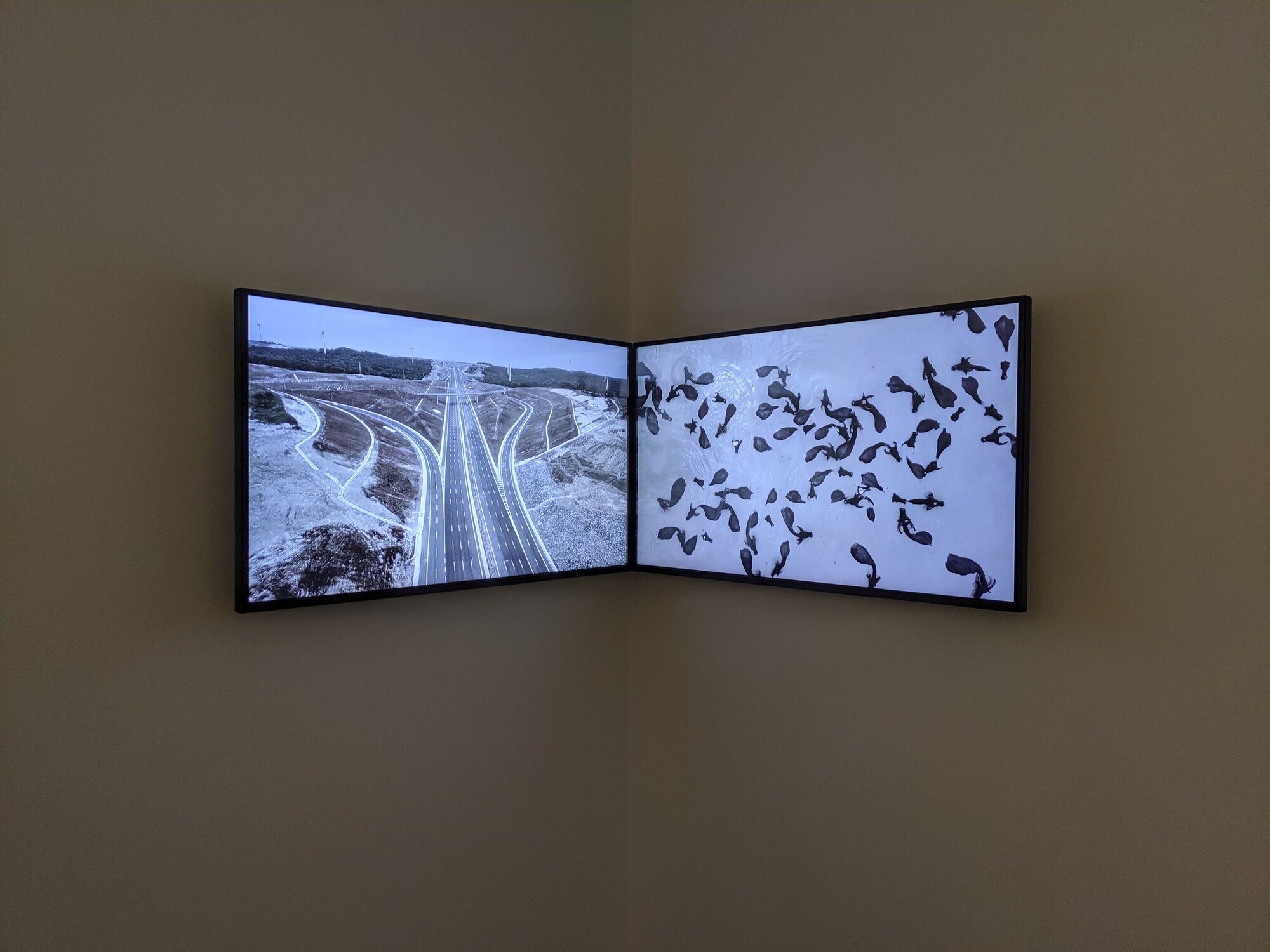
If our sociality itself causes the crisis, why go back to 2019 to examine post-crisis sociality? To answer this, we must look at how the temporality of the crisis is framed in the exhibition. Unlike normative modernity with its linear temporality, the biennial presents temporality as a highly complex and fluid structure. The relations of subject to object are much harder to identify compared to in the past. This relationship includes codifying things, de-codifying them when they become waste, and extracting them from the space that they occupy accordingly and re-codifying them for another use. For example, buffalos were used for farming by agricultural societies, but enhanced mechanization made them no longer needed for work. Now, they are only a source of food that is found in supermarket aisles. When buffalos are outside of order, outside of the state apparatus, they are seen either as waste or as unidentified beings. With human intervention, temporality exists as a plane in which the potential uses of things change progressively. Thus, it is impossible to think of ‘post-crisis sociality’ independently from crisis- and pre-crisis sociality. The crisis is unable to be narrated through fluid temporality unless the anthropocentric sociality attempts to fix the temporality. If we regard the Anthropocene as a trigger of relationships that lead to a crisis, the ecological crisis that was exhibited in 2019 becomes not the crisis of ecology, but the crisis of the Anthropocene, which involves complex relationships between humans and nature. Because the biennial highlights the process of transformation of things, not exposing them in their fixed status, the crisis cannot be narrated through a fixed temporality, but through relationality.
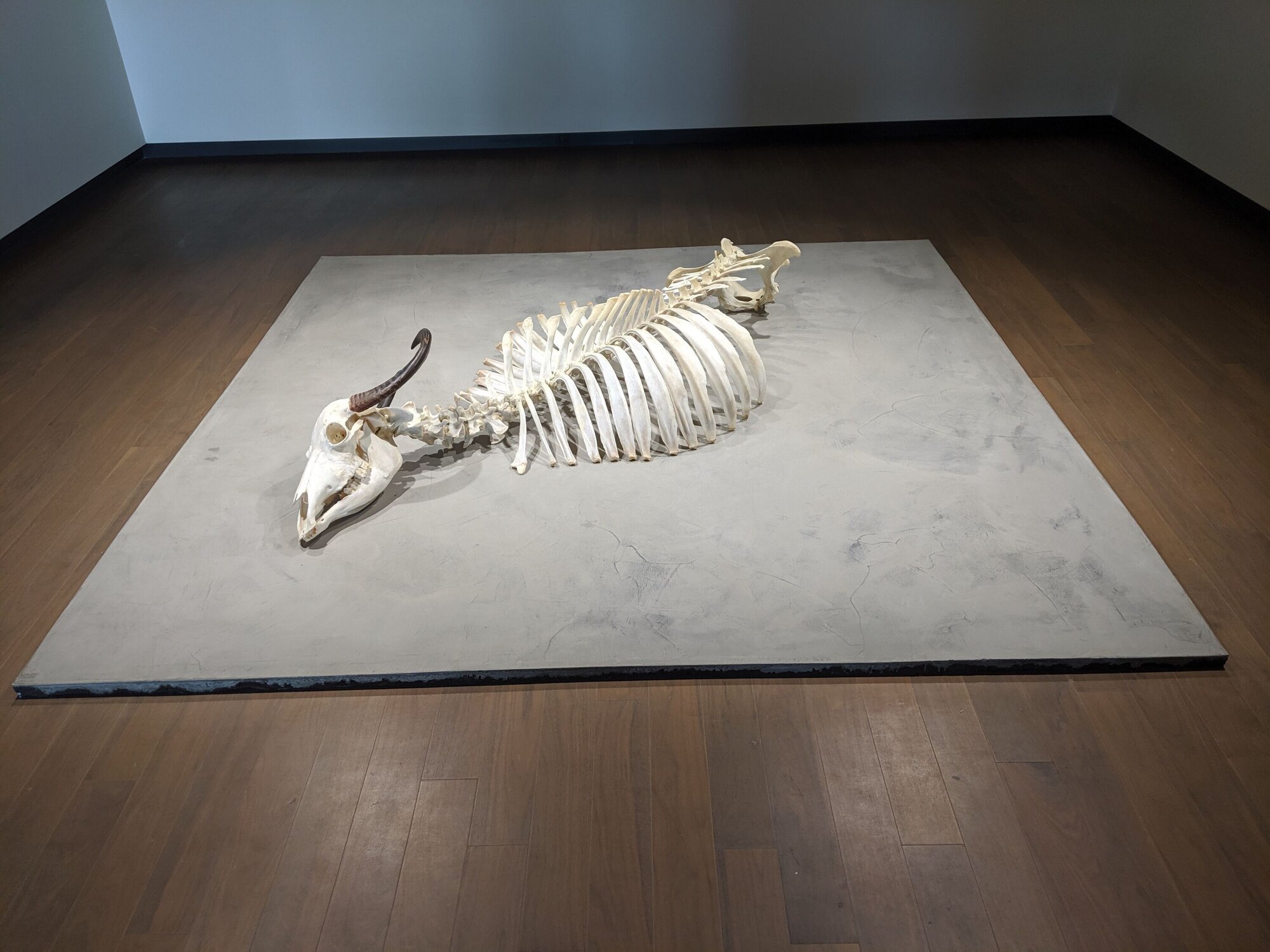
Rather than engaging with how the state articulates concepts, the Istanbul Biennial, as a ‘place of encounter,’ questioned the concept of waste. Apart from its physical presence, ‘waste’ implies production and consumption processes. The biennial focuses on what makes waste waste in the relationship between humans and nature. In Bourriaud’s (2019) words, using ‘molecular anthropology’ and acting like anthropologists, artists examine the interaction of human effects on nature with unidentified beings. However, the seventh continent, which emerged as a result of these relations, is a non-living formation that threatens humanity. This promises a sociality where the human is not the only actant, in the terms of Latour’s (1996) actor-network theory. Moving away from anthropocentrism as Latour (1996) calls us to, we see that sociality is constituted by both living and non-living entities. The seventh continent, the coronavirus, a refugee, a local, and other entities are actors that affect society. Hence, non-human beings have the power to change and shape society at least as much as humans. Emphasizing the complexity of relationships within a sociality that involves non-human beings, Latour (2013) proclaims, ‘before us, attachments; ahead of us, even more attachments,’ which lead to the ‘end of modernization’ (p. 10). In this sociality, wherein social networks are constituted through increasing attachments to non-living entities, it is no longer possible to determine a crisis’s distinct space and temporality. Time becomes an extension of eternity. As time passes, human actions lead to the emergence of new entities that engage with us. Thus, both the spatiality and temporality of the crisis become highly blurred. They cannot be pinned down with distinct descriptions.
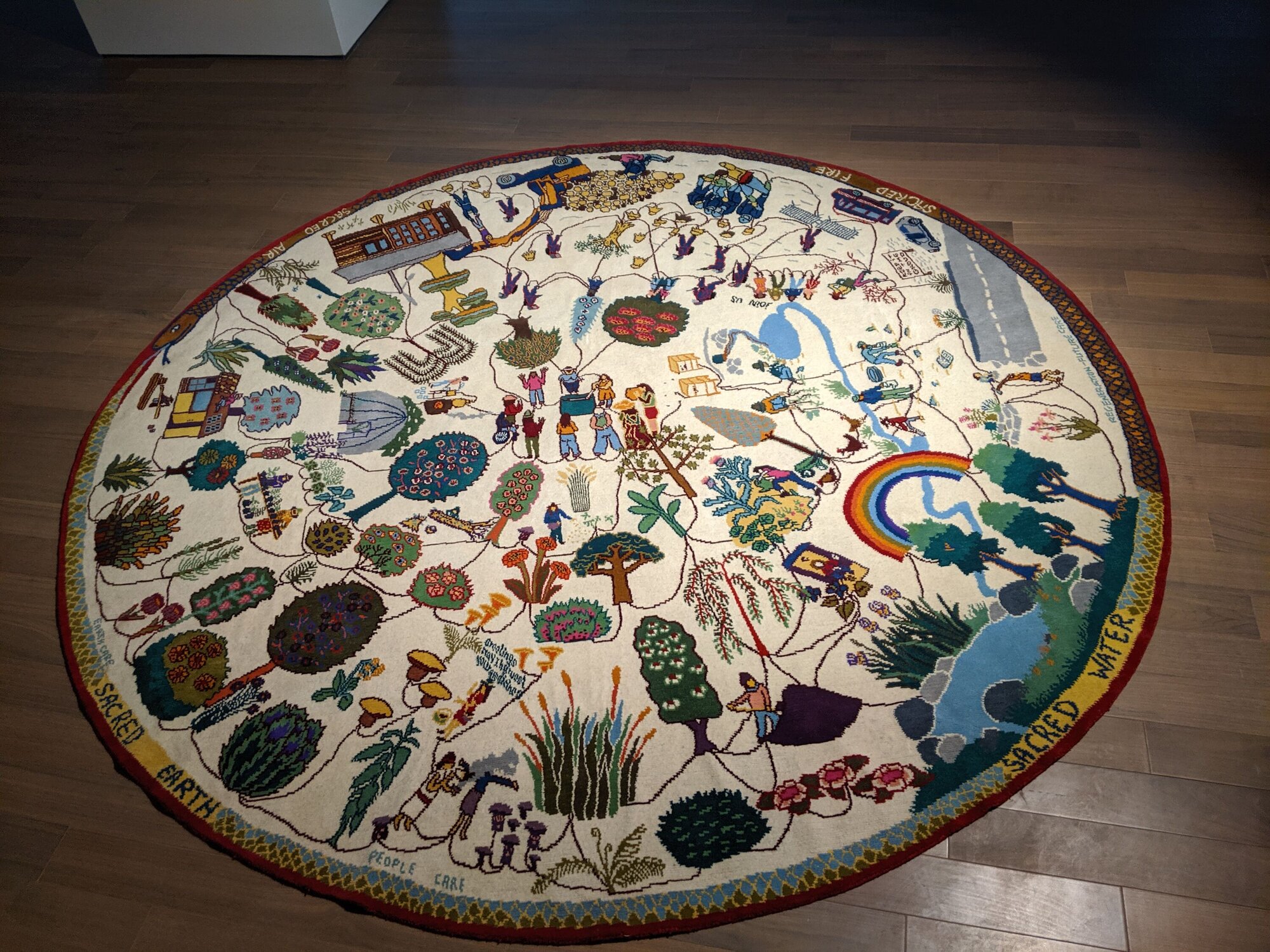
The seventh continent is both an area waiting to be discovered by ‘molecular’ excavation and a consequence that emerged through the wastes of an anthropocentric sociality. Thus, it is not distinctly a past or a future. It is both. In terms of spatiality, while the ‘continent’ is a nomad in fluid relation to the land, it is also a land, a smooth space, since it is a land of nomads, waste. The continent is also smooth in that its sociality is not hierarchically structured, as opposed to anthropocentric sociality. The relation of nomads to space and time is constructed rhizomatically: it depends on nature. A menacing nomad, the ‘continent’ emerges as a consequence of relationships between humans and objects. Ultimately, our current sociality appears as a ‘relational matrix’ that has been impacted not only by humans, but also by non-humans. A sociality in which time, space, and the concept of crisis are not colonized, can be revealed by an archeological examination of the relationship between humans and objects. This examination focuses on the meaning of an object in its natural background and its transformation by human intervention. Seen this way, it is not the nomad that makes a crisis a crisis, but the relation of the subject to the object: the process of the object’s nomadization.

Relational Sociality?
Finally, I want to come back to the issue of crisis. Take the example of the seventh continent: it is predicted that the mass of this island emerging in the Pacific will be equal to the mass of all fish in the world by the year 2050 (Hornak 2016). Scientists predict that the crisis will get bigger. The articulation of the crisis depends on our point of view. If we look at it from striated space, where everything is coded, we see the crisis as an obstacle, a situation that needs to be overcome by establishing new sets of rules. However, when the COVID-19 pandemic eventually ends, biological mutations in nature will continue to occur. Similarly, the end of the refugee crisis in Europe will not mark the end of civil wars and migrations. Thus, we can claim that causes of crises have always existed everywhere in the globe where an opposition between human and nature exists. In other words, neither attempting to depict the crisis’s temporality nor trying to pinpoint its location is rational, since the crisis impacts sociality as a whole as soon as it becomes involved in societal circulation.
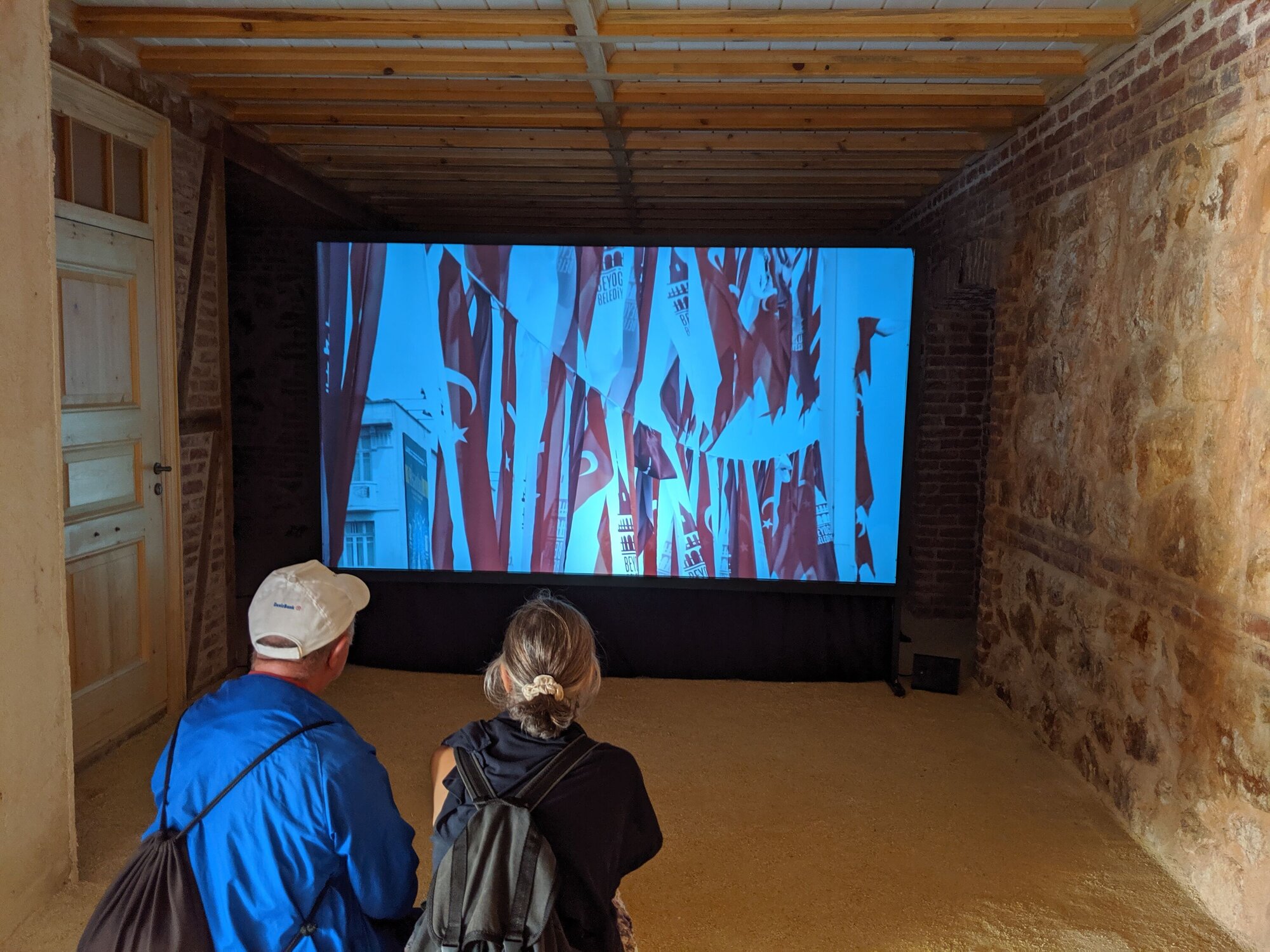
Rather than indicating where the crisis emerged, the Istanbul Biennial invites viewers to look at how and where the crisis is articulated. This is primarily achieved by displaying the ‘continent’ in Istanbul, in a place located geographically very far from the Pacific. Istanbul is the best place to exhibit the seventh continent not because it is the very center of the ecological crisis, but because this shows the globality of the crisis. All humanity lives under a threat that has emerged as a result of our current sociality, the Anthropocene. Moving back to the meaning of the continent, I have earlier asked why this seventh continent without a sociality is recognized as a continent. This can be answered only by moving away from anthropocentric thinking. That is, although the continent does not have a living population, relations of production and colonization exist there. In this way, any place on Earth where the ideology of colonization is present becomes the Seventh Continent.
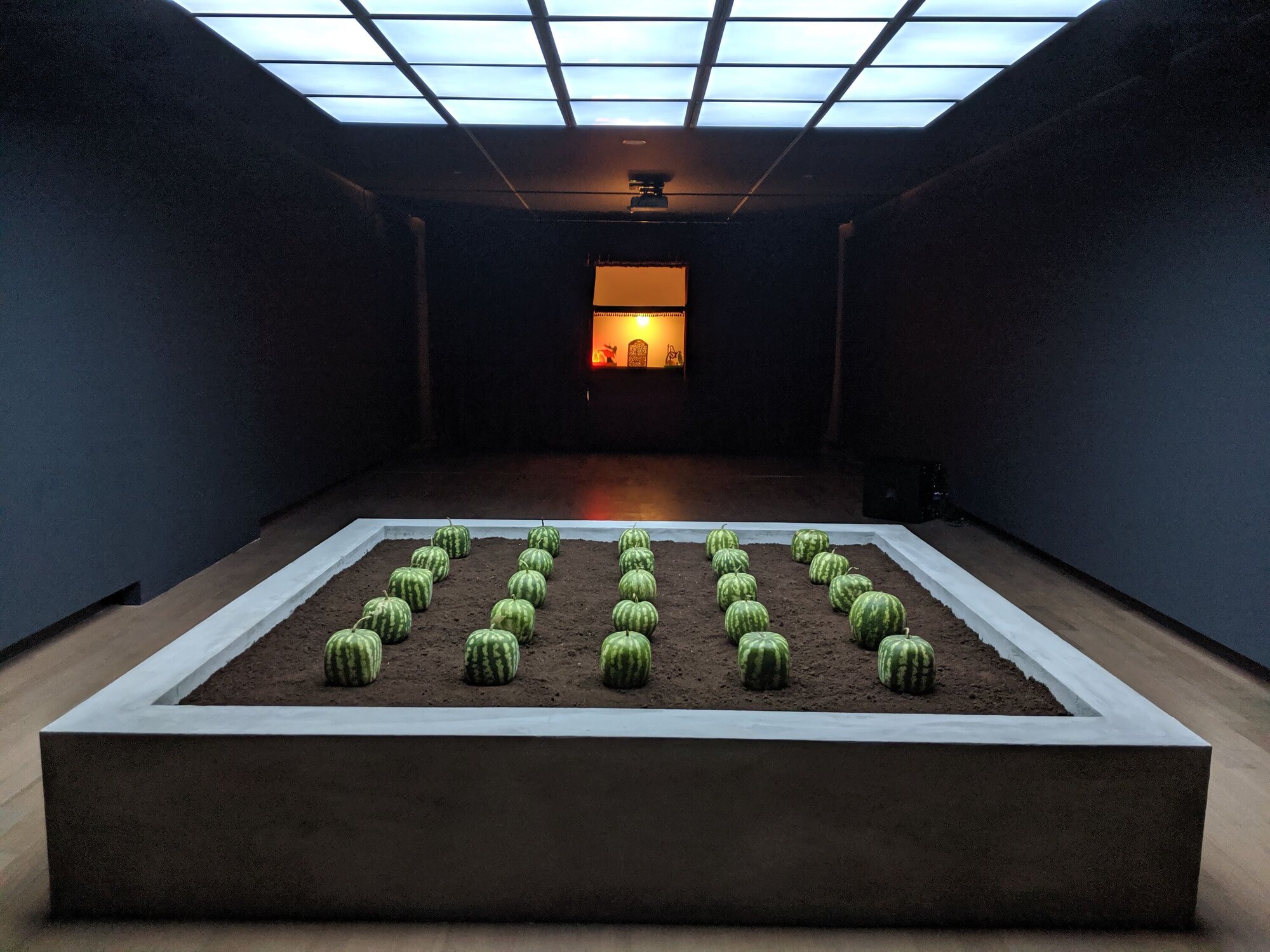
If we return to the title of the essay, ‘installing the crisis’ refers not only to the installation of artworks at the biennial, but also to how crises are installed in our new sociality. From the normative modern perspective, a new post-crisis sociality can be reached through reasoning, which requires a codification of time and space. But by expanding relational aesthetics to non-human spheres, the biennial promises the existence of a different sociality, where there are none of the hierarchically organized codes that belong to human-oriented socialities. The coded concept of space and time that existed in anthropocentric sociality is cast aside. This ‘new’ sociality becomes an entity that cannot be identified with temporality. Instead, it is identified with a complex relationality. Ultimately, the locations and temporality attributed to crises disappear in this sociality. Once the identifications of such concepts disappear, it is no longer possible to identify who we are and where we are. What constitutes us is our relation to other beings. Depending on the relationality, we are also made up of the consequences of pre-established relationships among other beings. That is, we—everyone who is part of this relational matrix—become the ‘waste’ that forms the ‘continent.’
Bibliography
- Bourriaud N (2002) Relational Aesthetics (Pleasance S; Woods F; Copeland M, trans). Paris, Les Presses du réel.
- Bourriaud N (2019) Curator’s statement. Istanbul Foundation for Culture and Arts, bienal.iksv.org/en/16th-istanbul-biennial/curator-s-statement (04.21.2021).
- Deleuze G and Guattari F (2005) A Thousand Plateaus: Capitalism and Schizophrenia (Massumi B, trans). Minneapolis, MS: University of Minnesota Press.
- Florida R (2020, June 25) The Lasting Normal for the Post-Pandemic City. Bloomberg CityLab, bloomberg.com/news/features/2020-06-25/the-new-normal-after-the-coronavirus-pandemic (03.03.2021).
- Holton R (1987) The Idea of Crisis in Modern Society. The British Journal of Sociology, 38(4): 502–520.
- Hornak L (2016, February 15) Will there be more fish or plastic in the sea in 2050? BBC News, bbc.co.uk/news/magazine-35562253 (04.21.2021)
- Latour B (1996) On actor-network theory: A few clarifications plus more than a few complications. Soziale Welt 47: 369–381.
- Latour B (2013) An Inquiry Into Modes of Existence (Porter C, trans). Cambridge, MA, Harvard University Press.
- Long NJ and Moore HL (2012) Sociality Revisited: Setting a New Agenda. The Cambridge Journal of Anthropology 30(1): 40–47.
- Spade VP (2010) Jean-Paul Sartre’s Being and Nothingness. Lecture notes, Indiana University Bloomington, Bloomington, IL. scholarworks.iu.edu/dspace/bitstream/handle/2022/19119/Sartre's%20Being%20and%20Nothingness%20--%20Class%20Notes.pdf (03.01.2021).
- Stark H and Saldanha A (2016) A New Earth: Deleuze and Guattari in the Anthropocene. Deleuze Studies 10(4): 427–439.
Footnotes:
1. ‘War machine’ is a term introduced by Deleuze and Guattari (2005) to refer to nomads that exist in smooth space. It is a formation opposite to the hierarchical structure of the state.
Author’s bio
Fatih Kalkan is a PhD student at the University of Leeds, United Kingdom. His research focuses on the refugee crisis in contemporary film curatorial practices. His areas of interest are film aesthetics, film festival studies, contemporary art, and cultural studies.


